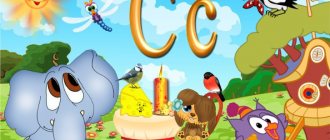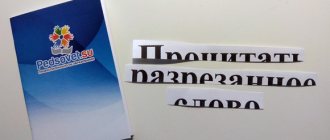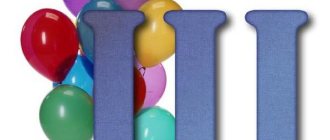Speech is the main means of communication among people. Therefore, it is so important that the child develops it correctly. One of the indicators is clear pronunciation of all sounds by the age of 5–6 years. And kids can’t do it without parental help. How to teach your child to say all the letters correctly? What should you do for this?
A bit of "general theory"
First of all, it is important to understand that a little person’s speech develops in stages. Experienced parents probably remember that in the first months of life their baby chanted vowel sounds, then began to hum, pronouncing syllables with simple consonants, then came the first onomatopoeia (“am-am”, “av-av”) and the first words.
- Closer to one year, the child can say “mom,” “dad,” “baba,” “uncle,” “give,” and perhaps several other words. He also uses the “wrong” words (“kup-kup”, “bye-bye”).
- From one to two years old, the baby learns to formulate the first simple sentences (“I’ll have soup”, “Dad, give me”). If the syntactic structure of a sentence (subject - predicate) can be traced, no attention is yet paid to the purity of sounds: the child’s articulatory apparatus is not yet sufficiently formed for this. But the so-called “passive” vocabulary, which began in the first months, is being replenished by leaps and bounds: the child learns to understand new words, remembers their pronunciation and meaning, although he does not yet know how to pronounce them. Later they will turn into his active speech. Now he no longer just pronounces the “vocabulary set”, but listens to how he says these words and the sounds in them, and is able to evaluate whether it is correct or not.
- Around 3 years old, a child learns to repeat short poems, as well as construct complex sentences with the words “because”, “which”, “so that”. Most often, it is at this age that whistling sounds (S, Z, C) “ripe.” But even if they are still being replaced (for example, by the sound T), but the child’s intelligence is developing normally (he understands speech addressed to him, knows the names of his relatives, or that animals also have mothers and fathers) - there is no reason to worry.
- By the age of 4, the child should know general words (what are dishes, transport, toys, clothes). The pronunciation may not yet be very clear (hissing and P are the ones that suffer most often).
- At the age of 5, a child must correctly pronounce all sounds, since by this time the parts of the brain responsible for the development of speech have been sufficiently formed, and the speech apparatus has reached the required “condition” (provided that the child has been constantly trained: speech itself is not will come “out of nowhere”).
Articulatory gymnastics for the sound t
It is necessary to do articulation exercises daily. Get used to the fact that in any free time you and your baby develop the speech apparatus.
More on the topic:
- Articulatory gymnastics for the sound Ш
- Exercises for sounds “S, C, Z”
Setting the T sound
- Choose several syllables or words that contain the letter combination TA, and repeat them at least 10 times.
- Place the tongue between the teeth and press it firmly, but at the same time so that it does not hurt the baby, with the jaw. Take a deep breath and, as you exhale, say an interdental T.
- Place your tongue between your teeth again. Stretch your teeth in a smile and “spit.” After this, give your jaw a rest.
- T is a derivative sound from P. Therefore, you can start warming up by practicing the sound P. Say Pa-Pa several times, while the wide part of the tongue should be pressed to the lower lip. Gradually stretch your lips into a smile and move on to pronouncing Ta-Ta.
- Place the tongue between the teeth. Say Pa-Pa again several times. At this moment, the adult spreads the child’s lips with his index finger and thumb. When the manipulation is performed correctly, Ta-Ta is pronounced.
How to properly give speech therapy massage to a child at home
Sound production
- Talk to the child Ta-Ta.
- A special paddle is used to soften the sound. Use it to press the tip of your tongue and lower it down. You should get the letter combination Tya.
- The sound Th is produced by clicking the tip of the tongue; the teeth should be closed at this time.
- You can complicate the exercise: do not press your tongue against the palate, but stick it out.
Speech development and parental involvement
So what is parental help? First of all, it is important for adults to understand that it is impossible to simply teach a child to say letters. This process is long, systematic and comprehensive. Children’s speech develops along with the improvement of other skills: both psychomotor and physical. If the baby is behind in development (he started holding his head up late, sitting up, he has problems with memory, attention) - speech will most likely also lag behind.
What needs to be done to ensure that everything happens on time? Firstly, monitor overall development - train muscles, dexterity, motor skills, memory, attention.
The following aspects are especially important for developing speech skills.
- From a very early age, parents should speak to the child clearly and correctly: without childish touching “lisping”, without adjusting words to the child’s age. Yes, a baby can speak incorrectly due to age-related imperfections of his speech apparatus. But he should hear only accurate speech around him: correct, clear, literate, without verbal garbage (“well this”, “damn”, “in short”, “what”), otherwise the incorrect pronunciation will become fixed in his speech and then these problems will arise adjust with specialists. And this is much more difficult.
- The process cannot be left to chance. With such a passive approach, the baby will certainly begin to lag behind. Teaching him the correct pronunciation is just as important as teaching him to hold a spoon or pull on tights.
- There should always be an active speech environment around the child. He must hear speech all the time. You need to comment on all actions, talk about everything that is happening, and name all the surrounding objects. Then the child from an early age will not only enrich his passive vocabulary, but also understand the importance of speech for communication.
What exactly are we developing?
First of all, of course, a passive dictionary. But it is not only he who contributes to the development of pronunciation skills. Thus, it has long been proven that the brain centers responsible for the development of fine motor skills and speech are located nearby and influence each other. Therefore, in order to ensure that the baby does not have problems with speech, it is important to pay attention to the development of fine motor skills. These could be activities such as:
- finger exercises or finger massage (at a very early age);
- sorting through cereals, small buttons, nuts;
- lacing, fastening zippers, buttons;
- screwing caps on bottles;
- finger painting on sand, semolina, flour;
- painting, modeling;
- stringing large beads on a string.
And in order for the speech apparatus to be in good shape, it needs to be constantly trained. For this purpose, special articulation gymnastics complexes have been developed. They help the child’s lips, tongue, jaws, and cheeks acquire the necessary strength, tone, mobility and controllability, learn the correct force and direction of air supply when speaking, and make speech rhythmic and beautiful. Only the correct functioning of these organs will help the baby master the necessary pronunciation. We talked about articulatory gymnastics in detail in this article.
When starting any classes with a preschooler, remember that they should last no more than 15 minutes. Pay attention to the baby's mood and willingness to accept the game. If he doesn’t want to, don’t insist, don’t force (especially don’t promise “heavenly punishment”!). Otherwise, having once felt such an attitude, the child may lose interest in any learning for the rest of his life or even begin to hate it.
how to teach a child to say the letter d
Continuing the theme of games with letters, I found more games on the website elenayanushko.ru. They can be played with both magnetic letters and cubes with letters, which you can buy on the website 100sale.ru.
Game “WORD TRANSFORMATIONS”
In this game we invite the child to be a wizard. And the secret of the “magic” is this: by replacing just one letter in a given word, you can turn it into another word with a completely different meaning. First, offer the simplest words for transformation, which consist of three letters (one syllable):
• JUICE - TOK - KOK: Ask the child to put out the word JUICE from the letters of the magnetic alphabet. Then offer to transform it, by changing just one letter, into what is in an electrical outlet. Give the child time to think and the opportunity to guess for himself that this is TOK. Then suggest, by changing one letter again, to turn this word into ship's cook (KOK).
• LION - FOREST: Lay out the word LION with your child. Then suggest turning the fearsome predator into a place where there are a lot of trees.
• BOW - VARNISH - LAZ: Invite your child to form the word BOW from magnetic letters. Then turn this vegetable into something that is used to paint nails (or cover furniture) - VARNISH. Then ask your child to turn the word LAC into a hole you can crawl through (PAP).
• BUG - BITCH - KNOCK - BOW: Invite your child to lay out the word BUG, then turn it into a sharp branch on a tree (BITCH), then into the sound made when you knock with a hammer (KNOCK). And then turn this word into a vegetable that is added to soup and salad.
• BOB - FOREHEAD: Together with your child, lay out the word BOB, explain that it means edible fruit. Then suggest turning the BOB into a part of the face (FOB).
• HOUSE - SMOKE: Give the child three letters - D, O, M - and ask them to lay out the word for the building (HOUSE). Then offer to turn this word into something that is formed when a fire burns (SMOKE).
• PEACE - Feast: What happens when there is no war? Invite your child to make out the word PEACE from magnetic letters. Then replace one letter so that the WORLD turns into a big feast where guests are treated to delicious food (FIRE).
In a similar way, you can play with other chains of words: COM - TOM - HOUSE, CHEESE - SOR - THIEF, BOR - BOY - SIDE, GOD - DOG, DAM - GIFT, OX - GOL - COLL - FLOOR, TANK - SIDE, BULL - BEECH, WAS - BAL, RICE - KIS.
If the child likes the game and has already learned to easily change simple words, you can offer more complex words for the game, consisting of 2-3 syllables:
• BOAT - SPOON: Together with your child, lay out the word BOAT. Then offer to replace one letter in the word so that what they swim on turns into what they eat (SPOON).
• RAM - BANANA: Make the word RAM out of magnetic letters. Then invite your child to turn it into a sweet foreign fruit.
• PEAS - CITY: Together with your child, make out the word PEAS from magnetic letters. Then propose to turn it into a place with many houses, roads and people.
• COW - CROWN: Have your child spell out the word COW and then change one letter so that the animal becomes the king's headdress.
The game can be continued with other words: SLIDE - MINK, SQUIRREL - BULL, TUCKA - HANDLE - BUG, DAY - STUM - SHADOW - LAZY, POINT - DAUGHTER - HUMM - BARREL - KIDNEY.
Game "SYLLABLE ESCAPE"
You can play a similar game with syllables: if you remove one syllable from some words, they turn into other words! But before offering this game to your child, it is worth getting acquainted with the syllable structure of the word. A little hint: clapping your hands while pronouncing the word at the same time helps to divide a word into syllables (one syllable - one clap).
• SAND - JUICE: Lay out the word SAND. Ask the child to read the word and clap to highlight the syllables, name the first syllable, the second syllable. Then invite your child to remove one syllable from the word so that it becomes a completely different word. If the child cannot guess on his own, you can give a hint: “Remove one syllable from the word SAND so that it turns into a delicious fruit drink” (JUICE).
• PIE - HORN: Invite the child to lay out the word PIE and name the word syllable by syllable. Then ask them to remove one syllable to make a new word. If the child finds it difficult, a hint is possible: “Remove one syllable from the word PIE so that the delicious food turns into something that grows on the nose of a rhinoceros.”
• HAMMOCK - POPPY: In a similar way (see description of the game above), ask the child to turn the bed for sleeping and relaxation into a flower.
Continue playing with other words (with or without descriptive clues): BUTTERFLY - BARREL, SWAMP - LOTO, SAILOR - CABLE, BOAT - DAUGHTER, BASKET - ZINE, ZUCCHIN - TANK, CHARTER - THRONE.
Game "MAGIC LETTERS"
There are amazing words that can become the subject of an entire fairy tale. Here is one of them:
VICTORY (Based on the fairy tale by S. Pogorelovsky)
One letter can do wonders.
Pencil drew a lawn. On it is a Pobeda car. He wrote under the picture: VICTORY (lay out this word from the alphabet letters with your child).
Hedgehog looked onto the lawn. He liked the letter P. “I’ll put it,” he thinks, “in front of my house.” There will be good gates." He put the letter on his back and carried it away. (Remove the letter P. Later, when reading a fairy tale, the child removes other letters - according to the text)
The gloomy Bear came. Began to complain:
- I don’t have one today...
“LUNCH,” the letters suggested.
- Right! - the Bear barked. - Oh, I wish I could eat some honey! Yes, stock up for the winter! Here, by the way, is the hoop for the tub.
He took the letter O under his arm and stomped off to the apiary. And the Bunny jumped out onto the lawn. Trembling, looking around. Suddenly I saw a terrible word: TROUBLE.
- Oh, where's the trouble? - Bunny rushed about.
Out of fright, he ran into the letter B. It bounced off and fell behind a rowan tree. And the Bunny rushed off into the forest.
The Stork has arrived. I saw a tasty word: FOOD. And there is definitely food in the grass: frogs - as many as you want. Stork attached a stick to the letter E to create a fork. The Stork ate, flew away and took away the fork.
Then the Ram came. He bleated offendedly:
- They say that I am stupid. Am I stupid?
And the letters for him:
- YES.
The Ram got angry. He ran up and hit the letter D with his horns. She crumbled into pieces. The last letter left - A. stands alone. What can she say without friends? Just cry bitterly: ah-ah!
If you quickly comfort the letter A, put friends and comrades next to it to create new words!
In the photo: Fun ABC cubes 12 pcs. 1111-4 https://100sale.ru/catalog/product/91516/
Preparing to produce sounds
There is no need to wait until 5–6 years to see that the child cannot pronounce some letters. Very often the problem can be prevented (and it is much easier than fixing it later). To teach a child to speak a sound, you just need to systematically perform a set of exercises, which, together with articulatory gymnastics, will help the baby’s organs “understand” how to behave when pronouncing certain sounds. Or letters - many call it that (although the sound is more correct: a letter is a graphic outline of a sound).
So, speech therapy exercises that will help the child pronounce sounds can be like this.
- We strengthen the muscles of the tongue so that it can remain at the top behind the upper teeth in a raised state for a long time. This is the defining moment for pronouncing the sounds [h], [sch], [sh], [zh], [l] and [r] - problematic for many children. Speech games are suitable for this (it is better to carry them out in poetic form, with some theatricalization of the process), in which the baby will have to repeat many times: “you-dy” (“tyn-dyn”), “so-so”, “dy-dy” ", "Yes Yes". These are the syllables in which you have to raise and hold the tongue at the top. Here it is important to vary the strength of the voice, intonation, speed of pronunciation, and also to ensure that the tip of the child’s tongue during exercises does not fall towards the lower teeth, but remains behind the upper teeth all the time.
- We strengthen the root of the tongue so that it can rise to the palate. This is necessary to pronounce the sounds [g], [k], [x]. Let the child imagine that he is a marksman, in front of whom there is a shooting range with targets. His task is to “hit” all the “targets” with a gun (the shot is “cough-cough”). You can “shoot” until the child gets tired. You can make the shooting range a reality by hanging targets and giving your child a water pistol. He must shoot with the same sound: [kh].
- We teach the baby to close his lips. Adenoids, malocclusion, or other features may cause a child to be unable to close their lips tightly. In this case, the pronunciation of the sounds [p], [b], [m] (these are just “labial” sounds) suffers greatly. To teach your child to pronounce them, you can play drummers or rain with thunder - the main thing is that during such a game he pronounces the characteristic syllables: “bom-bom”, “boom-boom”, “boom-boom”, etc. It is necessary to ensure that the baby’s lips close very tightly when performing such exercises, even slightly “overplayed.” This will strengthen the muscles around the mouth faster, and the child will be able to close his lips. Accordingly, he will be ready to pronounce labial sounds that are still difficult for him.
- We develop the cheeks. With the help of the “hamster” game, the baby will learn to use his cheeks - after all, they are also involved in pronunciation. We invite him to puff out his cheeks, as if his mouth is full of food, and begin to “chew” with concentration (cheeks puffed out, lips closed). At the same time, the jaws and almost all facial muscles also work.
Pronunciation of the T sound
We can highlight common mistakes made in the pronunciation of the T sound:
- replacing the sound T (it is front-lingual) with G and K (they are called back-lingual);
- mixing or rearranging consonants located next to the sound T (“rolled” instead of “glass”);
- after P or K, the T sound is lost and replaced with a softening (“piichka” instead of “birdie”);
- replacing the sounds Ch and C with T (“nine” instead of “girl”, “Petsya” instead of “Petya”).
Children who replace the T sound with some other sound often have incorrect articulation. The child raises his tongue to the palate, while the tip of the tongue should rest against the front teeth.
The reasons for incorrect pronunciation are as follows:
- malfunctions of the articulatory apparatus (speech organs);
- the lower jaw is weakly developed, which is why it is inactive during speech;
- the hearing organs are poorly developed, which is why the child cannot distinguish sounds by ear;
- imitating an adult who has problems with correct pronunciation.
Only a speech therapist can make a diagnosis. And parents, in turn, can practice at home the exercises recommended by a professional.









